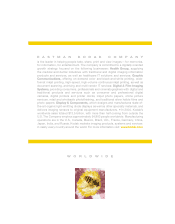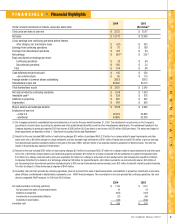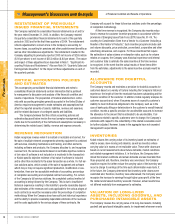Kodak 2004 Annual Report Download - page 9
Download and view the complete annual report
Please find page 9 of the 2004 Kodak annual report below. You can navigate through the pages in the report by either clicking on the pages listed below, or by using the keyword search tool below to find specific information within the annual report.
Financials
7
2004 SUMMARY ANNUAL REPORT
or changes in circumstances indicate that the carrying value may not be
recoverable. The Company assesses the recoverability of the carrying value
of long-lived assets, other than goodwill and purchased intangible assets
with indefi nite useful lives, by fi rst grouping its long-lived assets with other
assets and liabilities at the lowest level for which identifi able cash fl ows
are largely independent of the cash fl ows of other assets and liabilities (the
asset group) and, secondly, estimating the undiscounted future cash fl ows
that are directly associated with and expected to arise from the use of
and eventual disposition of such asset group. The Company estimates the
undiscounted cash fl ows over the remaining useful life of the primary asset
within the asset group. If the carrying value of the asset group exceeds the
estimated undiscounted cash fl ows, the Company records an impairment
charge to the extent the carrying value of the long-lived asset exceeds
its fair value. The Company determines fair value through quoted market
prices in active markets or, if quoted market prices are unavailable, through
the performance of internal analyses of discounted cash fl ows or external
appraisals. The undiscounted and discounted cash fl ow analyses are based
on a number of estimates and assumptions, including the expected period
over which the asset will be utilized, projected future operating results of
the asset group, discount rate and long-term growth rate.
To assess goodwill for impairment, the Company performs an assess-
ment of the carrying value of its reporting units on an annual basis or when
events and changes in circumstances occur that would more likely than not
reduce the fair value of the Company’s reporting units below their carrying
value. If the carrying value of a reporting unit exceeds its fair value, the
Company would record an impairment charge to earnings to the extent
the carrying amount of the reporting unit goodwill exceeds its implied fair
value. The Company estimates the fair value of its reporting units through
internal analyses and external valuations, which utilize income and market
valuation approaches through the application of capitalized earnings,
discounted cash fl ow and market comparable methods. These valuation
techniques are based on a number of estimates and assumptions, including
the projected future operating results of the reporting unit, discount rate,
long-term growth rate and appropriate market comparables.
The Company’s assessments of impairment of long-lived assets, in-
cluding goodwill and purchased intangible assets, and its periodic review of
the remaining useful lives of its long-lived assets are an integral part of the
Company’s ongoing strategic review of the business and operations, and
are also performed in conjunction with the Company’s periodic restructur-
ing actions. Therefore, future changes in the Company’s strategy, the ongo-
ing digital substitution, the continuing shift from overnight photofi nishing
to onsite processing and other changes in the operations of the Company
could impact the projected future operating results that are inherent in the
Company’s estimates of fair value, resulting in impairments in the future.
Additionally, other changes in the estimates and assumptions, including
the discount rate and expected long-term growth rate, which drive the
valuation techniques employed to estimate the fair value of long-lived as-
sets and goodwill could change and, therefore, impact the assessments of
impairment in the future.
In performing the annual assessment of goodwill for impairment, the
Company determined that no material reporting units’ carrying values were
close to exceeding their respective fair values. See “Goodwill” under Note
1, “Signifi cant Accounting Policies.”
INVESTMENTS IN
EQUITY SECURITIES
Kodak holds minority interests in certain publicly traded and privately held
companies having operations or technology within its strategic areas of
focus. The Company’s policy is to record an impairment charge on these
investments when they experience declines in value that are considered
to be other-than-temporary. Poor operating results of the investees or
adverse changes in market conditions in the future may cause losses or an
inability of the Company to recover its carrying value in these underlying
investments. As of December 31, 2004, the amount related to the above in-
vestments recorded in the Company’s Consolidated Statement of Financial
Position was $44 million.
INCOME TAXES
The Company records a valuation allowance to reduce its net deferred tax
assets to the amount that is more likely than not to be realized. At Decem-
ber 31, 2004, the Company has deferred tax assets for its net operating
loss and foreign tax credit carryforwards of $234 million and $189 million,
respectively, relating to which the Company has a valuation allowance of
$131 million and $0 million, respectively. The Company has considered
future market growth, forecasted earnings, future taxable income, the mix
of earnings in the jurisdictions in which the Company operates, and prudent
and feasible tax planning strategies in determining the need for these
valuation allowances. If Kodak were to determine that it would not be able
to realize a portion of its net deferred tax asset in the future for which there
is currently no valuation allowance, an adjustment to the net deferred tax
assets would be charged to earnings in the period such determination was
made. Conversely, if the Company were to make a determination that it is
more likely than not that the deferred tax assets for which there is currently
a valuation allowance would be realized, the related valuation allowance
would be reduced and a benefi t to earnings would be recorded.
The Company’s effective tax rate considers the impact of undistrib-
uted earnings of subsidiary companies outside of the U.S. Deferred taxes
have not been provided for the potential remittance of such undistributed
earnings, as it is the Company’s policy to permanently reinvest its retained
earnings. However, from time to time and to the extent that the Company
can repatriate overseas earnings on essentially a tax-free basis, the Com-
pany’s foreign subsidiaries will pay dividends to the U.S. Material changes
in the Company’s working capital and long-term investment requirements
could impact the decisions made by management with respect to the level
and source of future remittances and, as a result, the Company’s effective
tax rate. See Note 15, “Income Taxes.”
The Company operates within multiple taxing jurisdictions worldwide
and is subject to audit in these jurisdictions. These audits can involve
complex issues, which may require an extended period of time for resolu-
tion. Although management believes that adequate provision has been
made for such issues, there is the possibility that the ultimate resolution of
such issues could have an adverse effect on the earnings of the Company.
Conversely, if these issues are resolved favorably in the future, the related
provisions would be reduced, thus having a positive impact on earnings.






















